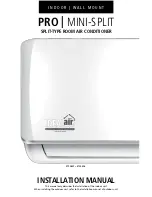
3.0 INSTALLATION
3.4 UNPACKING AND UNCRATING
Unless specified, the units are generally not wooden crated. Only light packaging with wooden
skid and wrapped around shrink-fit polystyrene sheet for waterproofing are provided. Care
should be taken in handling, moving or rigging the units to avoid damaged to the panels, paint
work and framework. All units or sections should be moved or trucked to their final location in
the vertical position. Under no circumstances should they be "walked" on the corners of the
units or crates.
1.) Remove shipping carton or crate.
2.) Remove skid from under the units
3.) Remove the rear access panel of the condensing section for access to the electrical box and
the compressor(s).
3.5 BLOWER SECTION
3.5.1 Discharge Pattern
Four blower discharge patterns are generally available for all models ( i.e. Patterns 1 to
4 as shown in Figure 3.5.1 ).
It is important to study the site layout and select the type of blower discharge pattern
to suit the ductwork direction which will minimize noise and vibration. The selected
blower discharge pattern should be specified in the purchase order ( or order form ) to
the factory. Avoid field conversion of blower discharge pattern! If field conversion of
the blower discharge pattern is required, contact factory or nearest Dunham-Bush
representative, and the field conversion should only be carried out under the
supervision of a factory authorized personnel.
3.5.2 Duct Connections
All ducts should be made in accordance with all local and/ or national codes and with
goods duct installation practices. Try to minimize unnecessary static losses by having
many bends.
Suspended ductwork with flexible hangers should not be fastened directly to the unit.
A length of straight duct shall be installed as per Figure 3.5.2. This is to ensure
uniform flow of discharge air. If an elbow need to be installed, then it shall be 1.5 of
equivalent duct diameter. Z(Equivalent duct Ø= (4ab/
π
)
0.5
).
Please refer to AMCA standard for proper ducting installation/ guidelines.











































